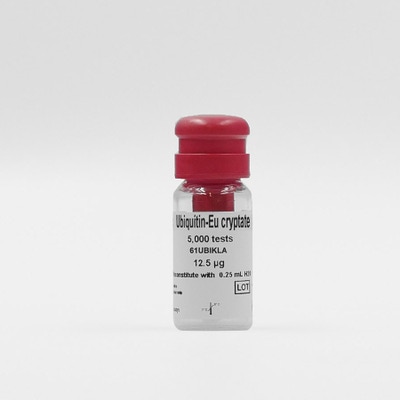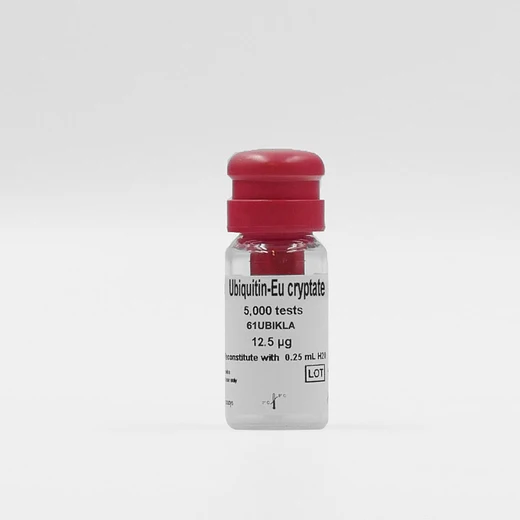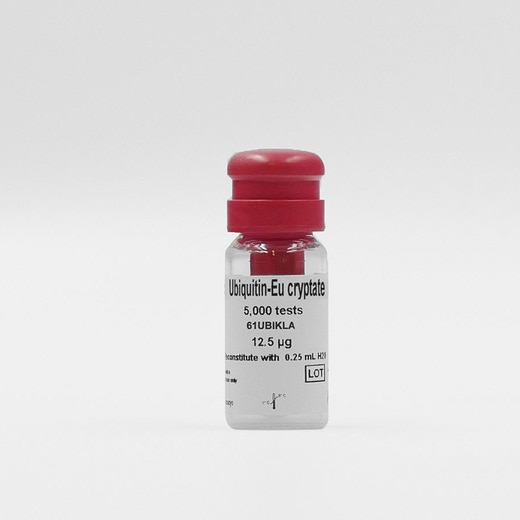

HTRF Ubiquitin Eu-Conjugate, 20,000 Assay Points


HTRF Ubiquitin Eu-Conjugate, 20,000 Assay Points






Ubiquitin labeled with Europium Cryptate to monitor protein ubiquitination
| Feature | Specification |
|---|---|
| Application | Protein-Protein Interaction |
Ubiquitin labeled with Europium Cryptate to monitor protein ubiquitination



HTRF Ubiquitin Eu-Conjugate, 20,000 Assay Points



HTRF Ubiquitin Eu-Conjugate, 20,000 Assay Points



Product information
Overview
Ubiquitination plays a key role in regulating protein degradation, and is carried out by the conjugation of ubiquitin to target proteins through the sequential activity of three enzymes: E1, E2 and E3. Poly-ubiquitinated proteins are then subject to degradation by proteasomes.
The ubiquitin pathway is associated with many pathologies such as cancer, muscle atrophy, inflammation, viral infection, and metabolic and neurodegenerative disorders. The Ubiquitin-Eu cryptate allows flexible assay development assessing each step in the ubiquitin pathway.
Specifications
| Application |
Protein-Protein Interaction
|
|---|---|
| Brand |
HTRF
|
| Detection Modality |
HTRF
|
| Product Group |
Fluorescent Reagent
|
| Shipping Conditions |
Shipped Ambient
|
| Target Class |
Binding Assay
|
| Technology |
TR-FRET
|
| Unit Size |
20,000 Assay Points
|
Video gallery

HTRF Ubiquitin Eu-Conjugate, 20,000 Assay Points

HTRF Ubiquitin Eu-Conjugate, 20,000 Assay Points

How it works
Assay principle
HTRF Ubiquitin assays use ubiquitin labeled with Europium cryptate. Upon the addition of XL665 conjugate, the HTRF signal is proportional to the level of ubiquitination, and remains stable for more than 24 hours. An example of a p53-polyubiquitination assay is shown here.

Assay protocol
HTRF ubiquitin assays have two basic phases: the enzymatic step, followed by the HTRF detection step. 1. Enzymatic step: The target protein is incubated with the ubiquitin enzymes (E2 & E3) and Eu3+-labeled ubiquitin. The reaction starts with the addition of E1 enzyme. 2. Detection step: The ubiquitinated target protein is then detected by the addition of an XL665-labeled reagent that contains EDTA to stop the enzymatic reaction.

Assay validation
p53 poly-ubiquitination assay
The figure on the right summarizes the results of a p53 poly-ubiquitination assay*
Eu3+-labeled ubiquitin was directly incorporated into the poly-ubiquitin chain on the biotinylated-p53 target protein:
200 nM Biotinylated-p53 was incubated with 300nM E2, 150nM E3, 200nM ATP, and a mixture of Ub-K/Ub (20/500 nM).
8 nM E1 was then added to start the reaction,
The ubiquitin reaction was stopped at various times by adding EDTA.
Poly-ubiquitinated p53 was measured by the addition of streptavidin-XL665.
The enzymatic reaction was linear for up to 50 minutes. The assay had CVs <5% and a S/B of 10 that was stable for several days.
*The ubiquitin assay was performed following the procedure as described by Yabuki et al. in Comb Chem High Throughput Screening. 1999 Oct;2(5):279-87

Resources
Are you looking for resources, click on the resource type to explore further.
This guide provides you an overview of HTRF applications in several therapeutic areas.


How can we help you?
We are here to answer your questions.






























